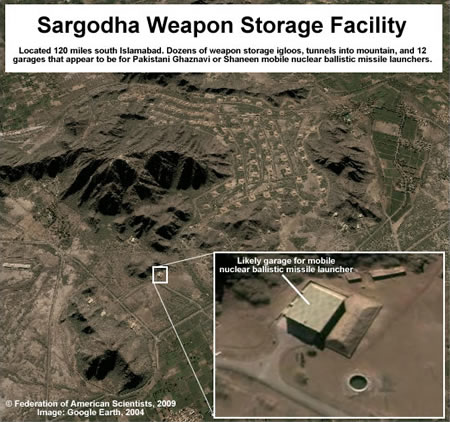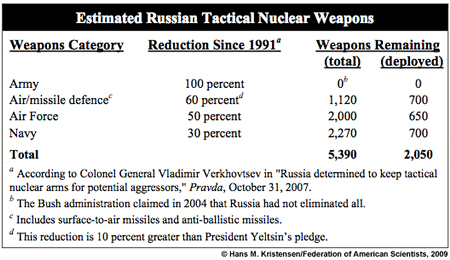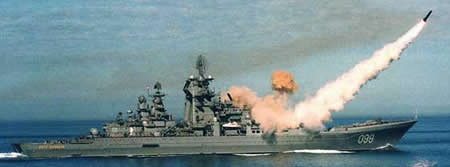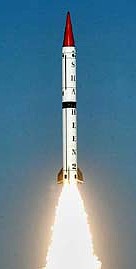Concern Over Pakistan’s Nuclear Weapons
 |
| Pakistan’s nuclear weapons are “widely dispersed” says Secretary of State Hillary Clinton. Does that include the large weapons storage complex at Sargodha? Click for image. |
.
By Hans M. Kristensen
Secretary of State Hillary Clinton has expressed concern over the safety of Pakistan’s nuclear weapons in the light of increasing violence in the country. The weapons “are widely dispersed in the country – they are not at a central location,” she said in what is perhaps the first U.S. public indication of its knowledge about how Pakistan stores its nuclear weapons.
We’re pleased that both Washington Times and the Carnegie Endowment use our estimates for how many nuclear weapons Pakistan and other countries have. For additional information about Pakistan’s nuclear forces, see:
* Preparation of Shaheen-2 ballistic missile launchers.
* Nuclear Notebook: Pakistan’s Nuclear Forces, 2007 (most recent update).
.
Russian Tactical Nuclear Weapons
 |
| New low-yield nuclear warheads for cruise missiles on Russia’s submarines?. |
.
By Hans M. Kristensen
Two recent news reports have drawn the attention to Russia’s tactical nuclear weapons. Earlier this week, RIA Novosti quoted Vice Admiral Oleg Burtsev, deputy head of the Russian Navy General Staff, saying that the role of tactical nuclear weapons on submarines “will play a key role in the future,” that their range and precision are gradually increasing, and that Russia “can install low-yield warheads on existing cruise missiles” with high-yield warheads.
This morning an editorial in the New York Times advocated withdrawing the “200 to 300” U.S. tactical nuclear bombs deployed in Europe “to make it much easier to challenge Russia to reduce its stockpile of at least 3,000 short-range weapons.”
Both reports compel – each in their own way – the Obama administration to address the issue of tactical nuclear weapons.
The Russian Inventory
Like the United States, Russia doesn’t say much about the status of its tactical nuclear weapons. The little we have to go by is based on what the Soviet Union used to have and how much Russian officials have said they have cut since then.
Unofficial estimates set the Soviet inventory of tactical nuclear weapons at roughly 15,000 in mid-1991. In response to unilateral cuts announced by the United States in late 1991 and early 1992, Russian President Boris Yeltsin pledged in 1992 that production of warheads for ground-launched tactical missiles, artillery shells, and mines had stopped and that all such warheads would be eliminated. He also pledged that Russia would dispose of half of all airborne and surface-to-air warheads, as well as one-third of all naval warheads.
In 2004, the Russian Foreign Ministry stated that “more than 50 percent” of these warhead types have been “liquidated.” And in September 2007, Defense Ministry official Colonel-General Vladimir Verkhovtsev gave a status report of these reductions that appeared to go beyond President Yeltsin’s pledge.
Based on this, Robert Norris and I make the following cautious estimate (to be published in the Bulletin of the Atomic Scientists in late April) of the current Russian inventory of tactical nuclear weapons:
 |
| Estimate from forthcoming Nuclear Notebook in the Bulletin of the Atomic Scientists. |
.
Based on the number of available nuclear-capable delivery platforms, we estimate that nearly two-thirds of these warheads are in reserve or awaiting dismantlement. The remaining approximately 2,080 warheads are operational for delivery by anti-ballistic missiles, air-defence missiles, tactical aircraft, and naval cruise missiles, depth bombs, and torpedoes. The Navy’s tactical nuclear weapons are not deployed at sea under normal circumstances but stored on land.
The Other Nuclear Powers
The United States retains a small inventory of perhaps 500 active tactical nuclear weapons. This includes an estimated 400 bombs (including 200 in Europe) and 100 Tomahawk cruise missiles (all on land). Others, perhaps 700, are in inactive storage.
France also has 60 tactical-range cruise missiles, including some on its aircraft carrier, although it calls them strategic weapons.
The United Kingdom has completely eliminated its tactical nuclear weapons, although it said until a couple of years ago that some of its strategic Trident missiles had a “sub-strategic” mission.
Information about possible Chinese tactical nuclear weapons is vague and contradictory, but might include some gravity bombs.
India, Pakistan, and Israel have some nuclear weapons that could be considered tactical (gravity bombs for fighter-bombers and, in the case of India and Pakistan, short-range ballistic missiles), but all are normally considered strategic.
| Russian Nuclear-Capable Cruise Missile Launch |
 |
| A nuclear-capable SS-N-19 Shipwreck cruise missile is launched from a Kirov-class nuclear-powered guided missile cruiser. The ship is equipped with 20 launchers for the SS-N-19 missile, which can carry a 500-kiloton warhead. Other tactical nuclear weapon systems include the SS-N-16 anti-submarine rocket, and the SA-N-6 anti-air missile. |
.
Implications and Issues
Whether Vice Admiral Burtsev’s statement is more than boasting remains to be seen, but it is a timely reminder to the Obama administration of the need to develop a plan for how to tackle the tactical nuclear weapons.
Russia’s nuclear posture is now approaching a situation where there are more tactical nuclear weapons in the inventory than strategic weapons. And NATO’s remnant of the Cold War tactical nuclear posture in Europe seems stuck in the mud of nuclear dogma and bureaucratic inaction.
None of these tactical nuclear weapons are limited or monitored by any arms control agreements, and – for all the worries about terrorists stealing nuclear weapons – are the most easy to run away with.
In April, NATO is widely expected to kick off a (long-overdue) review of its Strategic Concept from 1999. It would be a mistake to leave the initiative on what to do with the tactical nuclear weapons to the NATO bureaucrats. The vision must come from the top and President Obama needs to articulate what it is soon.
US Arms Sales to Pakistan: New CRS Report
 A new Congressional Research Service report on “U.S. Arms Sales to Pakistan” recently obtained by the FAS provides a succinct overview of recent U.S. arms sales to General Pervez Musharraf’s regime, the tumultous fifty-year history of US security assistance to Pakistan, and presidential authority to stop such sales. The release of the report coincides with a worsening political crisis in Pakistan and growing Congressional and public discontent over the United States’ multi-billion dollar military aid program for General Musharraf’s beseiged and increasingly authoritarian regime.
A new Congressional Research Service report on “U.S. Arms Sales to Pakistan” recently obtained by the FAS provides a succinct overview of recent U.S. arms sales to General Pervez Musharraf’s regime, the tumultous fifty-year history of US security assistance to Pakistan, and presidential authority to stop such sales. The release of the report coincides with a worsening political crisis in Pakistan and growing Congressional and public discontent over the United States’ multi-billion dollar military aid program for General Musharraf’s beseiged and increasingly authoritarian regime.
(more…)
Article: Pakistani Nuclear Forces, 2007
 |
|
Shaheen 2 launch |
By Hans M. Kristensen
Pakistan is preparing its next-generation of nuclear-capable ballistic missile for deployment. A satellite image taken on June 5, 2005, shows what appears to be 15 Transporter Erector Launchers (TELs) for the medium-range Shaheen 2 fitting out at the National Defense Complex near Fatehjang approximately 30 kilometers southwest of Islamabad.
The vehicles were discovered as part of preparations for the latest Nuclear Notebook on Pakistani nuclear forces published in the May/June issue of the Bulletin of the Atomic Scientists. The Notebook is written by Hans M. Kristensen of the Federation of American Scientists and Robert S. Norris of the Natural Resources Defense Council.
The authors estimate that Pakistan currently has an arsenal of about 60 nuclear weapons. In the last five and a half years, Pakistan has deployed two new nuclear-capable ballistic missiles, entered the final development stages of a potentially nuclear-capable cruise missile, started construction of a new plutonium production reactor, and is close to completing a second chemical separation facility. As Pakistan completes development of two more nuclear-cable ballistic missiles and a cruise missile in the next few years, the nuclear arsenal will increase further.
| Pakistani government responds to blog:The government downplayed a report by an organization of American scientists that Pakistan is preparing its next generation nuclear-capable ballistic missile for deployment. “This is a speculative report which contains part fact and part fiction,” is how the spokesperson characterized the report.”Source: Dawn, “N-Capable Missiles,” May 11, 2007. |
The main driver for Pakistan’s nuclear modernization appears to be India’s nuclear build-up, although national prestige probably also is a factor. The two countries appear to be entering a new phase in their regional nuclear arms race with medium-range ballistic missiles gradually replacing aircraft as the backbone of their nuclear strike forces. In contrast to aircraft, ballistic missiles have a very short flight time and cannot be recalled once launched.
(more…)
Nuclear Missile Testing Galore
 (Updated January 3, 2007)
(Updated January 3, 2007)
North Korea may have gotten all the attention, but all the nuclear weapon states were busy flight-testing ballistic missiles for their nuclear weapons during 2006. According to a preliminary count, eight countries launched more than 28 ballistic missiles of 23 types in 26 different events.
Unlike the failed North Korean Taepo Dong 2 launch, most other ballistic missile tests were successful. Russia and India also experienced missile failures, but the United States demonstrated a very reliable capability including the 117th consecutive successful launch of the Trident II D5 sea-launched ballistic missile.
The busy ballistic missile flight testing represents yet another double standard in international security, and suggests that initiatives are needed to limit not only proliferating countries from developing ballistic missiles but also find ways to curtail the programs of the existing nuclear powers.
The ballistic missile flight tests involved weapons ranging from 10-warhead intercontinental ballistic missiles down to single-warhead short-range ballistic missiles. Most of the flight tests, however, involved long-range ballistic missiles and the United States, Russia and France also launched sea-launched ballistic missiles (see table below).
|
Ballistic Missile Tests |
||
| Date | Missile | Remarks |
| China | ||
| 5 Sep | 1 DF-31 ICBM |
From Wuzhai, impact in Takla Makan Desert. |
| France | ||
| 9 Nov | 1 M51 SLBM | From Biscarosse (CELM facility), impact in South Atlantic. |
| India | ||
| 13 Jun | 1 Prithvi I SRBM |
From Chandipur, impact in Indian Ocean. |
| 9 Jul | 1 Agni III IRBM |
From Chandipur. Failed. |
| 20 Nov | 1 Prithvi I SRBM |
From Chandipur, impact in Indian Ocean. |
| Iran** | ||
| 23 May | 1 Shahab 3D MRBM |
From Emamshahr. |
| 3 Nov | 1 Shahab 3 MRBM, as well as “dozens” of Shahab 2, Scud B and other SRBMs |
Part of the Great Prophet 2 exercise. |
| North Korea*** | ||
| 4 Jul | 1 Taepo Dong 2 ICBM and 6 Scud C and Rodong SRBMs |
From Musudan-ri near Kalmo. ICBM failed. |
| Pakistan | ||
| 16 Nov | 1 Ghauri MRBM |
From Tilla? |
| 29 Nov | 1 Hatf-4 (Shaheen-I) SRBM |
Part of Strategic Missile Group exercise. |
| 9 Dec | 1 Haft-3 (Ghaznavi) SRBM |
Part of Strategic Missile Group exercise. |
| Russia | ||
| 28 Jul | 1 SS-18 ICBM | Attempt to launch satellite, but technically an SS-18 flight test (see comments below). |
| 3 Aug | 1 Topol (SS-25) ICBM |
From Plesetsk, impact on Kura range. |
| 7 Sep | 1 Bulava SLBM |
From Dmitry Donskoy (Typhoon) in White Sea. Failed. |
| 9 Sep | 1 SS-N-23 SLBM |
From K-84 (Delta IV) at North Pole, impact on Kizha range. |
| 10 Sep | 1 SS-N-18 SLBM |
From Delta III in Pacific, impact on Kizha range. |
| 25 Oct | 1 Bulava SLBM |
From Dmitry Donskoy (Typhoon) in White Sea. Failed. |
| 9 Nov | 1 SS-19 ICBM |
From Silo in Baykonur, impact on Kura range. |
| 21 Dec | 1 SS-18 ICBM |
From Orenburg, impact on Kura range. |
| 24 Dec | 1 Bulava SLBM |
From White Sea. Third stage failed. |
| United States | ||
| 16 Feb | 1 Minuteman III ICBM |
From Vandenberg AFB, impact Kwajalein. Final W87/Mk-21 SERV test flight. |
| Mar/Apr | 2 Trident II D5 SLBMs |
From SSBN. |
| 4 Apr | 1 Minuteman III ICBM |
From Vandenberg AFB, impact near Guam. Extended-range, single-warhead flight test. |
| 14 Jun | 1 Minuteman III ICBM |
From Vandenberg AFB, impact Kwajalein. Three-warhead payload. |
| 20 Jul | 1 Minuteman III ICBM |
From Vandenberg AFB, impact Kwajalein. Three-warhead flight test. Launched by E-6B TACAMO airborne command post. |
| 21 Nov | 2 Trident II D5 SLBMs |
From USS Maryland (SSBN-738) off Florida, impact in South Atlantic. |
| * Unreported events may add to the list. ** Iran does not have nuclear weapons but is suspected of pursuing nuclear weapons capability. *** It is unknown if North Korea has developed a nuclear reentry vehicle for its ballistic missiles. |
||
The Putin government’s reaffirmation of the importance of strategic nuclear forces to Russian national security was tainted by the failure of three consecutive launches of the new Bulava missile, but tests of five other missile types shows that Russia still has effective missile forces.
Along with China, Russia’s efforts continue to have an important influence on U.S. nuclear planning, and the eight Minuteman III and Trident II missiles launched in 2006 were intended to ensure a nuclear capability second to none. The first ICBM flight-test signaled the start of the deployment of the W87 warhead on the Minuteman III force.
China’s launch of the (very) long-awaited DF-31 ICBM and India’s attempts to test launch the Agni III raised new concerns because of the role the weapons likely will play in the two countries’ targeting of each other. But during a visit to India in June 2006, U.S. Chairman of the Joint Chiefs of Staff, General Peter Pace, downplayed at least the Indian issue saying other countries in the region also have tested missiles. In a statement that North Korea would probably find useful to use, Gen. Pace explained that “the fact that a country is testing something like a missile is not destabilizing” as long as it is “designed for defense, and then are intended for use for defense, and they have competence in their ability to use those weapons for defense, it is a stabilizing event.”
But since all “defensive” ballistic missiles have very offensive capabilities, and since no nation plans it defense based on intentions and statements anyway but on the offensive capabilities of potential adversaries, Gen. Pace’s explanation seemed disingenuous and out of sync with the warnings about North Korean, Iranian and Chinese ballistic missile developments.
The Missile Technology Control Regime (MTCR) seeks to limit the proliferation of ballistic missiles, but that vision seems undercut by the busy ballistic missile launch schedule demonstrated by the nuclear weapon states in 2006. Some MTCR member countries have launched the International Code of Conduct Against Ballistic Missile Proliferation initiative in an attempt to establish a norm against ballistic missiles, and have called on all countries to show greater restraint in their own development of ballistic missiles capable of delivering weapons of mass destruction and to reduce their existing missile arsenals if possible.
All the nuclear weapons states portray their own nuclear ballistic missile developments as stabalizing and fully in compliance with their pledge under the Non-Proliferation Treaty to pursue nuclear disarmament in good faith. But fast-flying ballistic missiles are inherently destablizing because of their vulnerability to attack may trigger use early on in a conflict. And the busy missile testing in 2006 suggests that the “good faith” is wearing a little thin.
Lawmakers Scold Administration Over F-16 Sale to Pakistan
At Thursday’s hearing on the sale of 36 F-16 aircraft to Pakistan, Assistant Secretary of State John Hillen endured tongue-lashings from several members of the House International Relations Committee (HIRC), who objected to the manner in which his bureau has managed the $5.1 billion arms package. Of particular concern was the administration’s unilateral decision to waive the customary 20-day pre-notification for major arms sales, which many members viewed as a deliberate attempt to circumvent the committee’s authority. The decision – and the confrontation it provoked – could have far-reaching consequences, not only for Congressional oversight of arms sales but also several key State Department initiatives.
(more…)
Pakistan to receive 36 F-16 fighter jets
On Monday, the Bush administration announced a massive $5.1 billion arms package for Pakistan, the largest arms sale to the Indian subcontinent since US sanctions were suspended in 2001. The package includes 36 F-16 fighter jets, armaments, and upgrades for its existing fleet of F-16s. The announcement came five days after the administration officially notified Congress of the sales.
The deal is significant for many reasons. It will help to modernize Pakistan’s aging airforce, and help pave the way for an even larger fighter jet sale to India. The sale also has tremendous symbolic significance. In 1991, the first Bush Administration imposed various sanctions on Pakistan for its nuclear weapons program, the most high profile of which was the impounding of 28 F-16s purchased by Pakistan in the 1980’s. Pakistan lobbied hard for their release but the Bush and Clinton administrations held firm, and the planes came to symbolize the post-Cold War deterioration of US-Pakistani relations. Following the September 11th attacks, the US hastily sought to mend diplomatic fences with Pakistan, which has provided critical support in the War on Terror. The Bush administration immediately lifted the ban on military aid to India and Pakistan and gradually increased the quantity and sophistication of weapons exports to both countries. The F-16 sale, which still tops the list of weapons sought by the Pakistani government, signifies a completion of the rapprochement between the US and its erstwhile ally.
(more…)
US Air Force Publishes New Missile Threat Assessment
 The Air Force has published a new report about the threat from ballistic and cruise missiles. The new report, Ballistic and Cruise Missile Threat, presents the Air Force National Air and Space Intelligence Center’s (NASIC) assessment of current and emerging weapon systems deployed or under development by Russia, China, India, Pakistan, North Korea, Iran, Syria and others.
The Air Force has published a new report about the threat from ballistic and cruise missiles. The new report, Ballistic and Cruise Missile Threat, presents the Air Force National Air and Space Intelligence Center’s (NASIC) assessment of current and emerging weapon systems deployed or under development by Russia, China, India, Pakistan, North Korea, Iran, Syria and others.
Among the news in the report is a different and higher estimate for China’s future nuclear arsenal than was presented in the previous NASIC report from 2003. Whereas the previous assessment stated that China in 15 years will have 75-100 warheads on ICBMs capable of reaching the United States, the 2006 report states that this number will be “well over 100” warheads. NASIC also believes that a new Chinese cruise missile under development will have nuclear capability.
Also new is that NASIC reports that the Indian Agni I ballistic missile has not yet been deployed despite claims by the Indian government that the weapon was “inducted” into the Indian Army in 2004. Contrary to claims made by some media and experts, the NASIC report states that the Indian Bramos cruise missile does not have a nuclear capability. The Babur cruise missile under development by Pakistan, however, is assessed to have a nuclear capability.
A copy of the report, which was published in March 2006 and recently obtained by the Federation of American Scientists, is available in full along with previous versions here.